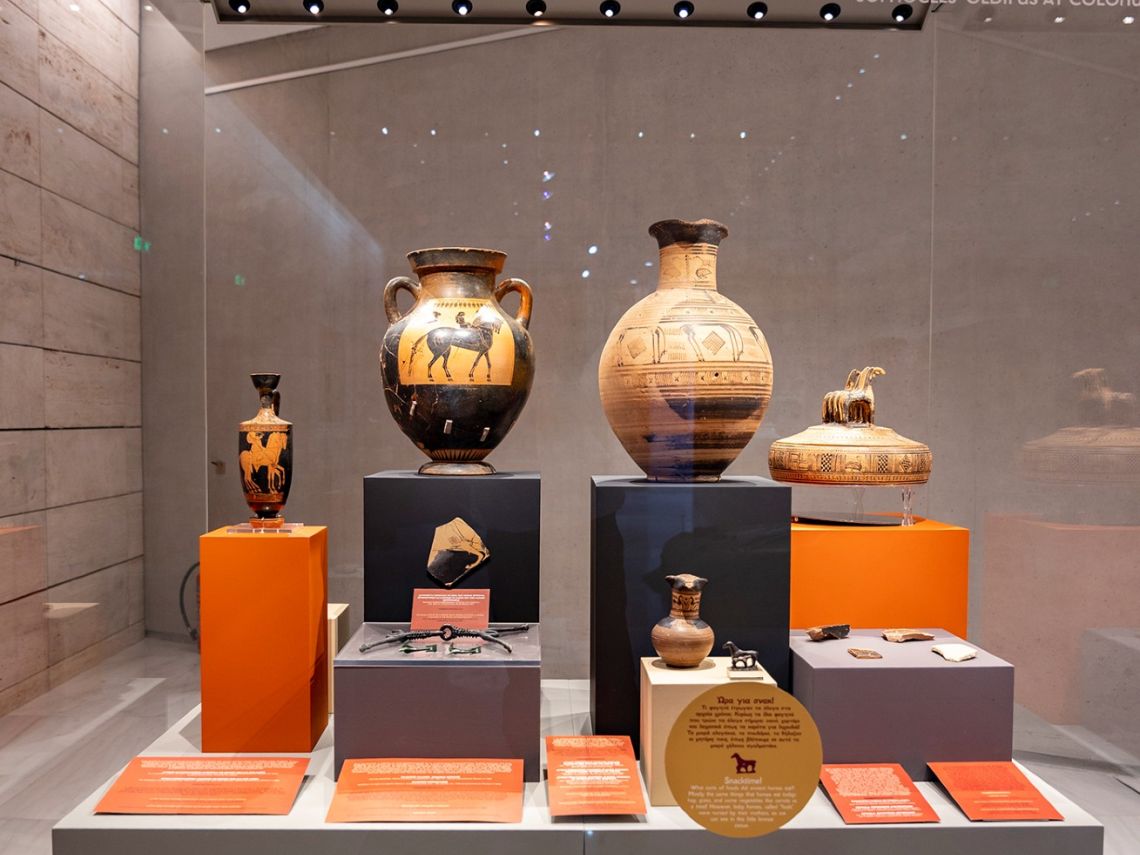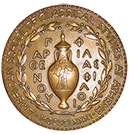Wealthy aristocratic Athenians known as hippotrόphoi bred, raised, and trained horses to compete in prestigious equestrian competitions, to participate in the hunt, and serve in the cavalry. The frequent appearance of horses on Attic ceramics beginning in the Geometric period, indicates that they were highly prized and served as status symbols for their owners. Greek art provides the best evidence for the appearance of ancient horses. From the earliest depictions they are tall and elegant with a slender head, an arched neck and hindquarters, a lean body, and long legs.
The scientific name for horses in ancient Greek was ta lόphοura, that is “animals with long-haired tails”. Greek horses were of medium build, 130-140 cm tall (from the ground to the top of the shoulders), and came in a range of colors: red (pyrros), white (lefkos), chestnut (xanthos), brown (melas) or dappled (valios). They could live up to 25 years but after 20 were no longer useful for racing or battle, although Bucephalus, the most famous Greek horse in antiquity, lived to be 30.
Xenophon’s handbook on horsemanship shows us how much the ancient Greeks valued and respected their horses and paid special attention to their care and training. He even advised owners to pet their horse in places it enjoys and for the groom to calm it when it is frightened and uneasy and teach it that there is nothing to be afraid of. He also recommended using a trainer knowledgeable in the arts of horsemanship and one who is gentle rather than harsh.
-
bf3i796707 wo

-
bf3i797109 wo
Horses’ fodder consisted of fresh grass, barley, oats, spelt, hay, and water, and Homer even mentions wine. Xenophon speaks of ‘breakfast’ and ‘dinner’ so it appears that horses, like humans, were fed twice a day. Small bronze figurines of foals nursing were made in Athens, but were probably inspired by prototypes from Argos.
Oinochoe (wine jug) with grazing stallions Attic Geometric, ca. 725-700 - BCE
Found in a female burial north ofthe Eridanos river - Kerameikos Museum 4217
Ephorate of Antiquities of the City of Athen
-
bf3i798112 wo
The bridle with its metal mouth-piece, known as a bit, and spurs were the only means of controlling and directing a horse in antiquity. The rider did not have the benefit of a saddle with stirrups, nor did the horse wear horse shoes for rough ground. The curved cheek-piecesand sharp protrusions on the bit indicate that it is Persian and so it was probably dedicated to Athena after the victory at Marathon in 490 BCE. The Greeks may have invented the spur since it is first mentioned by late 5th century comic poets.
Their use is shown in art by the ankle straps used to secure them on the rider’s leg.Bronze bit, possibly Persian From the Acropolis, Archaic debris pit, ca. 480 BCE Athens National Archaeological Museum X 7180
Bronze spurs from a grave in ancient Trichonio, Aetoloakarnania, 4th-3rd centuries BCE Athens National Archaeological Museum X13162
-
bf3i799514 wo 565 1140 855 80 c
In Athenian vase painting young riders are often shown with a second riderless ‘trace’ horse in the background. The youth is presumed to be a groom leading his master’s horse. Both of these vases had funerary uses: the amphora containing the burial of an infant, and the lekythos serving as a perfumed oil flask in a grave in Eretria. The black-figure painter Lydos was a master at depicting horses, and this stunning amphora was a valued object as is clear from themany lead rivets used to repair it.
Lekythos with rider and two horses Attic red-figure, attributed to the Syracuse Painter ca. 460 BCE
From a grave in Eretria - Athens National Archaeological Museum A1306
-
bf3i7983133
In Athenian vase painting young riders are often shown with a second riderless ‘trace’ horse in the background. The youth is presumed to be a groom leading his master’s horse. Both of these vases had funerary uses: the amphora containing the burial of an infant, and the lekythos serving as a perfumed oil flask in a grave in Eretria. The black-figure painter Lydos was a master at depicting horses, and this stunning amphora was a valued object as is clear from themany lead rivets used to repair it.
Amphora with rider and two horses Attic black-figure attributed to the painter Lydos,ca. 550 BCE found in a grave at Glyphada
Piraeus Museum ΜΠ 14265 Ephorate of Antiquities of Piraeus and the Islands
-
ostrako ippokrates combined
Another Athenian manifestation of horse mania is the frequent use of names using the term Hippos/-ippos. These appear in texts and inscriptions, but also on the ostraka (pots sherds) that Athenians used as voting tokens. They would write on them the name of the person they wanted banished from the city. Here we see the names of two elite Athenian citizens scratched on pot-sherds: Hippokrates (=horse + power), who was none other than the brother of the democratic reformer Kleisthenes and the grandfather of Perikles whose father was named Xanthippos (=blonde + horse).
Ostraka: HIPPOKRATES ALKMEONIDOU From the Athenian Agora, ca. 490-480 BCE
Agora Excavations P 6036 and P 15593
Ephorate of Antiquities of the City of Athens
-
ostrako xanthipos combined
Another Athenian manifestation of horse mania is the frequent use of names using the term Hippos/-ippos. These appear in texts and inscriptions, but also on the ostraka (pots sherds) that Athenians used as voting tokens. They would write on them the name of the person they wanted banished from the city. Here we see the names of two elite Athenian citizens scratched on pot-sherds: Hippokrates (=horse + power), who wasnone other than the brother of the democratic reformer Kleisthenes and the grandfather of Perikles whose father was named Xanthippos (=blonde + horse).
Ostraka: XANTHIPPOS ARRIPHRONOS From the Athenian Agora, 484 BCE
Agora Excavations P 32560 and P 32559
Ephorate of Antiquities of the City of Athens
Horses’ fodder consisted of fresh grass, barley, oats, spelt, hay, and water, and Homer even mentions wine. Xenophon speaks of ‘breakfast’ and ‘dinner’ so it appears that horses, like humans, were fed twice a day. Small bronze figurines of foals nursing were made in Athens, but were probably inspired by prototypes from Argos.
Oinochoe (wine jug) with grazing stallions Attic Geometric, ca. 725-700 - BCE
Found in a female burial north ofthe Eridanos river - Kerameikos Museum 4217
Ephorate of Antiquities of the City of Athen
The bridle with its metal mouth-piece, known as a bit, and spurs were the only means of controlling and directing a horse in antiquity. The rider did not have the benefit of a saddle with stirrups, nor did the horse wear horse shoes for rough ground. The curved cheek-piecesand sharp protrusions on the bit indicate that it is Persian and so it was probably dedicated to Athena after the victory at Marathon in 490 BCE. The Greeks may have invented the spur since it is first mentioned by late 5th century comic poets.
Their use is shown in art by the ankle straps used to secure them on the rider’s leg.
Bronze bit, possibly Persian From the Acropolis, Archaic debris pit, ca. 480 BCE Athens National Archaeological Museum X 7180
Bronze spurs from a grave in ancient Trichonio, Aetoloakarnania, 4th-3rd centuries BCE Athens National Archaeological Museum X13162
In Athenian vase painting young riders are often shown with a second riderless ‘trace’ horse in the background. The youth is presumed to be a groom leading his master’s horse. Both of these vases had funerary uses: the amphora containing the burial of an infant, and the lekythos serving as a perfumed oil flask in a grave in Eretria. The black-figure painter Lydos was a master at depicting horses, and this stunning amphora was a valued object as is clear from themany lead rivets used to repair it.
Lekythos with rider and two horses Attic red-figure, attributed to the Syracuse Painter ca. 460 BCE
From a grave in Eretria - Athens National Archaeological Museum A1306
In Athenian vase painting young riders are often shown with a second riderless ‘trace’ horse in the background. The youth is presumed to be a groom leading his master’s horse. Both of these vases had funerary uses: the amphora containing the burial of an infant, and the lekythos serving as a perfumed oil flask in a grave in Eretria. The black-figure painter Lydos was a master at depicting horses, and this stunning amphora was a valued object as is clear from themany lead rivets used to repair it.
Amphora with rider and two horses Attic black-figure attributed to the painter Lydos,ca. 550 BCE found in a grave at Glyphada
Piraeus Museum ΜΠ 14265 Ephorate of Antiquities of Piraeus and the Islands
Another Athenian manifestation of horse mania is the frequent use of names using the term Hippos/-ippos. These appear in texts and inscriptions, but also on the ostraka (pots sherds) that Athenians used as voting tokens. They would write on them the name of the person they wanted banished from the city. Here we see the names of two elite Athenian citizens scratched on pot-sherds: Hippokrates (=horse + power), who was none other than the brother of the democratic reformer Kleisthenes and the grandfather of Perikles whose father was named Xanthippos (=blonde + horse).
Ostraka: HIPPOKRATES ALKMEONIDOU From the Athenian Agora, ca. 490-480 BCE
Agora Excavations P 6036 and P 15593
Ephorate of Antiquities of the City of Athens
Another Athenian manifestation of horse mania is the frequent use of names using the term Hippos/-ippos. These appear in texts and inscriptions, but also on the ostraka (pots sherds) that Athenians used as voting tokens. They would write on them the name of the person they wanted banished from the city. Here we see the names of two elite Athenian citizens scratched on pot-sherds: Hippokrates (=horse + power), who wasnone other than the brother of the democratic reformer Kleisthenes and the grandfather of Perikles whose father was named Xanthippos (=blonde + horse).
Ostraka: XANTHIPPOS ARRIPHRONOS From the Athenian Agora, 484 BCE
Agora Excavations P 32560 and P 32559
Ephorate of Antiquities of the City of Athens







